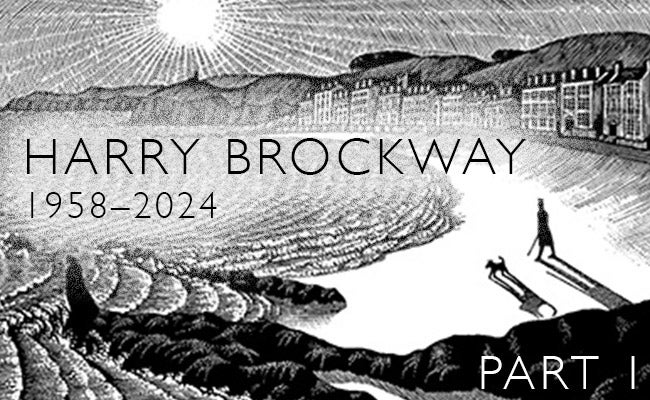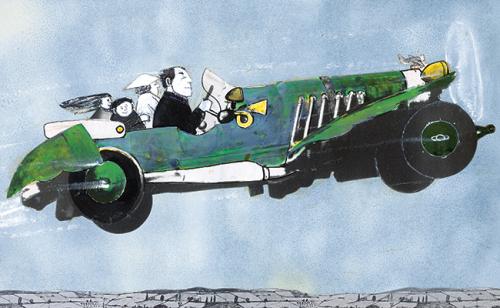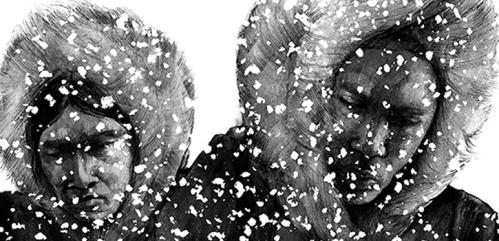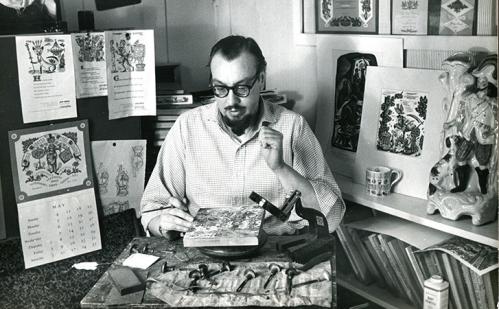Harry Brockway 1958–2024. PART ONE 1988–2004
Distinguished British wood engraver and stone carver Harry Brockway, who worked with the Folio Society from 1988 to 2021, sadly passed away on 1 January 2024. Joe Whitlock Blundell, who worked as The Folio Society's Production Director for over 30 years and was responsible for many of Brockway's commissions with Folio, takes a retrospective look over the work of this outstanding artist.
Of all the distinguished group of wood engravers who worked regularly on Folio books in the late 20th and early 21st centuries, Harry Brockway was the youngest, the strongest and the fittest, making his death on 1 January this year particularly shocking and saddening.
Harry was only 28 when he was commissioned to contribute frontispiece engravings to two plays in the Folio Shakespeare set, All's well that ends well and The Merchant of Venice.

It is interesting to compare his engraving for The Merchant of Venice (above) with that for Othello, which dates from a decade later, when the set was reissued and certain plays were reallocated to other artists. While The Merchant of Venice is a fine image, with lovely patterns and textures (a feature of Harry's work throughout his career), it is relatively conventional; but in Othello we have the mature Brockway, focusing intensely on the relationship between the three principals, depicting Othello's furious jealousy and Desdemona's bewildered innocence, while the menacing, manipulative Iago lurks in the background. Note the expressive contrast between Desdemona's elegant fingers and Othello's tense, dangerous, fist!

In 1989 Harry was one of the six artists chosen to illustrate Shakespeare's Sonnets, and again he achieved a rare intensity, notably in Sonnet 14, which concludes "Thy end is truth's and beauty's doom and date" and 115, "Now I love you best":


Harry's first commission for a complete book was Anne Brontë's Agnes Grey. Every one of the fourteen engravings is a little masterpiece, starting with the frontispiece portrait of Agnes:

In many of these engravings, Harry seems to be influenced by folk art, though the face in the next illustration, 'The Letter', also has more than a hint of Edward Gorey:

Here is my favourite of the engravings. The text reads, "the sun and the sea so dazzled my eyes in that direction… Then I turned again to delight myself with the sight and the sound of the sea dashing against my promontory – with no prodigious force, for the swell was broken by the tangled seaweed and the unseen rocks beneath." The extended shadows of the gentleman and the dog literally foreshadow the importance of the forthcoming encounter with Mr Weston.

Past illustrators of Huckleberry Finn have tended to treat it as a prank-filled caper similar to Tom Sawyer, but the books are really very different in character, and Harry took a more serious approach to Twain's masterpiece, focusing on the relationship between Huck and Jim the runaway slave. Here, printed on the title page, they are on the raft, "Then we lit the pipes, and dangled our legs in the water and talked about all kinds of things."

Next, as they are just about to be run down by a steamboat, "All of a sudden she bulged out, big and scary, with a long row of wide-open furnace doors shining like red-hot teeth."

And finally, after Jim has been recaptured, "Jim and me laid into that grindstone and walked her along like nothing."

At around that time, Folio published a series of miniature books with appropriately miniature engravings, and Harry was chosen to illustrate a selection of Garden Poems by Andrew Marvell. Here is an extract from 'The Garden', a poem which describes the merging of humankind and nature:

Energy and dynamism are depicted in a tiny compass in 'The Mower':

In the early days of the Folio Society it was usual for artists to be commissioned for non-fiction works, as well as for fiction and poetry, and this practice was revived for John Prebble's Glencoe and Culloden, a two-volume set. Harry chose to illustrate the books almost entirely with portraits, and I think they rank among his finest, if not his best-known, achievements. From Glencoe here are Alasdair Og and John MacDonald, together with King James II:


and from Culloden, Alexander Macdonald, Major General Henry Hawley, Stewart Carmichael of Bonnyhaugh and the Duke of Cumberland; the difference of mood between the opposing sides, the Scots and the English, is most striking, as is the use of telling background details:




These two volumes were later joined by a third, The Highland Clearances, for which he took a different approach, concentrating on the miseries of the thousands of crofters who were expelled from their land. Here we see a group of them scraping a living by gathering kelp along the shore, alongside a tender depiction of the "freezing and homeless":


The portrait theme was continued, this time in a fictional context and with exceptionally large blocks, in Harry's next book, Crime and Punishment by Dostoevsky. Here is the protagonist Raskolnikov, followed by the father and daughter, Semyon Zakharovich Marmeladov and Sofya Semyonovna Marmeladova:



It was clear by now that Harry was capable of getting to grips with all forms of literature, and when Folio came to publish the Complete Novels of George Eliot he was not daunted by the longest, and arguably toughest, of her books, Daniel Deronda. Here he adopted a very different approach; gone are the close-ups, and in their place are elegant full-length figures, sometimes curiously elongated (perhaps he had been studying Mannerist painting). Here are two depictions of the heroine, Gwendolyn, first with Daniel and then with Grandcourt's mistress, Lydia:


For the Essays by Francis Bacon, instead of the usual full-page or half-page illustrations Harry was asked to cut some smaller blocks for use as tailpieces. The publishers were expecting a few generic images, which could be repeated as often as necessary; Harry had other ideas, creating no fewer than 44 images, each of which wittily picks up on the theme of the preceding essay, and all linked by a scroll motif. Here are just four of them, 'Revenge', 'Vicissitudes', 'Unity in Religion', and 'Youth and Age'.




This survey of Harry's earlier work for Folio concludes with a book he was ideally suited to, and which gave him particular pleasure, Mary Shelley's Frankenstein. Here are two of the ten full-page images, taken from the beginning and the end of the story; first the eponymous scientist amid the Arctic ice:

then the monster he goes on to create, who has himself travelled to the Arctic for his final immolation: "I shall ascend my funeral pile triumphantly, and exult in the agony of the torturing flames."

The final part of this tribute to the wood-engraver Harry Brockway, covering his Folio work from 2005 to 2021, will appear shortly.





